Overview
I first wrote this review for SlingCommunity.com back on March 28th, when the first public beta of the software was released. Now that it has ‘gone gold’ and the official release is out, I decided to update it with all new screenshots, and revised it to reflect the changes made to the final version.
I’ll start by saying something that may seem strange. I’m a long time Sling fan – but a short time user. I only purchased my Slingbox Pro in February of 2007, but I’ve been watching Sling Media and keeping tabs on their products since they launched. I’ve always thought they had interesting ideas and products. I’m a geek, and I love gadgets. I’ve been a TiVo user since early 2002, and, of course, I run this site.
So, you may be asking, why did I wait so long to buy one? I don’t travel a lot, so I didn’t really have a major need for one. But that’s not the only reason. I’ve been a Palm OS user since 1998. I’ve had a Palm IIIx, Handspring Visor Deluxe, Sony Clie NZ-90, and Palm Treo 650. Since Sling didn’t support Palm OS, I couldn’t use it as often as I might.
The other use I might have for a Slingbox would be accessing my main A/V system from the TV in my bedroom. But that would require some manner of client device, a SlingCatcher, if you will.
At CES this year, Sling Media announced both a Palm OS client and a SlingCatcher, thereby removing my excuses for not having one. At the show I talked to Sling about obtaining the Palm OS client.
In February I was offered the opportunity to have early access to the client, to gain experience with it in order to prepare the first version of this review to go live in conjunction with the release of the first public beta. Officially, the client is only supported on the Palm Treo 700p and 755p, as they support EV-DO data connections. However, I’m in the other camp, using GSM via AT&T (formerly Cingular).
Still, I couldn’t pass this opportunity up, so I immediately purchased a Slingbox Pro and HD Connect to integrate with my main A/V stack. At the time the software did not function on my Treo 650, so I also upgraded to a Treo 680. As it turns out, very early in testing users figured out how to get the software working on the 650, and later versions ran on the 650 ‘out of the box’. The final release works equally well on the 650 and the 680, though it is not officially supported.
While the Treo 680 is not officially supported, I will say that, in my experience, the software works just fine on the 680. The only issue is that EDGE does not provide as fast a connection as EV-DO, but it works so long as the EDGE connection is solid and reliable.
I will say that you really don’t want to try streaming video over GPRS, so you really do need to be somewhere where you can get a solid EDGE connection to use the software successfully. I understand that 1xRTT doesn’t work well for the CDMA users either, and you really need an EV-DO connection. This is unsurprising, streaming video isn’t low-bandwidth friendly.
The Palm TX and LifeDrive have WiFi, of course. I don’t have either of these to test with myself, but I’ve seen reports that it works very well. The software has not been optimized for the 320×480 screens on these devices, or for use in landscape mode, but this is a 1.0 release which is focused primarily on the current big sellers. You may see improved support for the additional capabilities of those devices in the future.
The most extensive use I’ve made of the SlingPlayer Mobile software came in February when I visited my parents in Florida. I was there for two weeks, including a 5-day side trip to Walt Disney World, so I had plenty of time to play with SPM on my Treo. It worked very well, except for periods when I was in an area with weak EDGE coverage. And those were fairly early builds. The software has only improved since then.
Using SlingPlayer Mobile on Palm OS
The software is currently available for download from the US or download from the Canadian Sling Media sites. Or you can use Blazer on your Palm and download directly. You can try the software for 30 days before buying a license to continue using it. If you decide to continue, the license is USD$29.99 or CAD$34.99.
During the 30-day trial period it will prompt you to register each time you start the client, counting down the number of days until the free trial expires.
Adding your Slingbox is straight forward, see the screen capture tour below. Once you’ve connected to your Slingbox, playback is easy. The player UI is fairly minimal, but functional. I would like to see the UI better reflect the device being controlled, much as the desktop player has different remotes for different devices. While the screen is too small to allow for a full remote, it would be nice to have the icons change in the remote bar. But that’s a minor quibble.
The player UI is always present, there is no way to eliminate it and play the video full screen. However, I don’t think that’s an issue as the screen (on all by the TX and LifeDrive) is 1:1, aka square, and video is generally 4:3 or 16:9. While the video uses the full width of the screen, it cannot also use the full height without being distorted, so there is room for the UI. 4:3 video at the full 320 pixel width, needs only 240 pixels vertically. And the UI elements uses that ‘spare’ 80 pixels. 16:9 content needs even less vetical spavce.
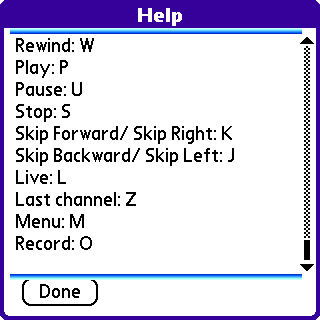
Navigation is simple and effective. The best tip to learn is that hitting the space bar turns on ’123′ mode. This allows you to use the 5-way pad for on-screen navigation on connected devices. When using something like TiVo, this allows you to use the 5-way pad just like the controls on the TiVo remote. I also suggest learning the keyboard shortcuts (see the screenshot to the right) as they make life much easier.
My only real complaint is that the navigation is a bit 5-way-centric. As an old-time Palm OS user, I tend to use the screen a lot. But there are things you can do from the 5-way that you can’t do with the touch screen. For example, if you enter the Remote Control screens you can go ‘up’ in the menu hierarchy by using ‘left’ on the 5-way, but all you can do on-screen is close the menu and return to the video. I’m used to Palm OS apps being fully navigable from the screen, so this still catches me at times. It isn’t a major problem, but I would like to see it corrected in a future update.
One issue which is mostly out of Sling Media’s hands is battery life. The Treo 680 has a small battery, and playing video consumes a fair bit of power, so you may want to purchase one of the third-party, extended life batteries and/or spare batteries if you plan to watch a lot of video away from a charger. I believe the 700p has a similarly sized battery. This isn’t unique to SlingPlayer. Other video players, such as Kinoma, also use the battery at similar rates.
The battery life issue was a rallying point for many testers. It gave rise to a number of requests for a battery indicator that could be used from within SPM. And Sling listened, it was a last minute addition in the final release.
Picking Nits
There are a few things I’d like to see changed or improved about the client. I realize this is a first release, and it is a good job, so consider these simply suggestions for the future.
The Help menu could be broken into a sub-menu screen instead of 16 screens to scroll through. Especially as the single most useful piece of information in there, the Keyboard Shortcuts, are the last thing in there. I suspect many people will never get that far, and will therefore be unaware of the shortcuts. Break the help into topic areas and give each a menu item.
An Image Zoom function would be nice. To avoid distorting the image when viewing a 16:9 source, you need to set the SlingPlayer to be Letterboxed. But, for example, if you’re watching 4:3 content off of an HD TiVo, the TiVo will pillarbox the content. Combined you end up with black bars all the way around the video, wasting screen space. It would be nice to be able to zoom the video area to use the available space.
One thing I definitely noticed in using the early releases of SPM on Palm OS with my TiVos was the lack of an Instant Replay keyboard shortcut. Thankfully, this was resolved before the final release. And one of the newly expanded shortcut keys is for Instant Replay.
If I dare to dream, I’d like to see the keyboard shortcuts user-defined. Allow users to alter the shortcuts and define their own to best suit their needs.
SlingPlayer Tour
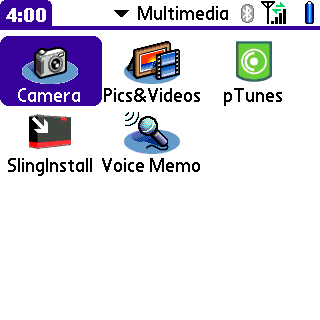
When you first download, or transfer, the PRC to your Palm, this is the icon that you will see. Once you start the installer, you’re presented with the End User License Agreement (EULA). Forty-six screens of EULA. No one is going to read it. I didn’t. I did, however, take screenshots of the whole shebang, and I’ll include them below.
If you’re installing on a device other than the Treo 700p or 755p, you will see this warning about SPM not being optimized for your device.
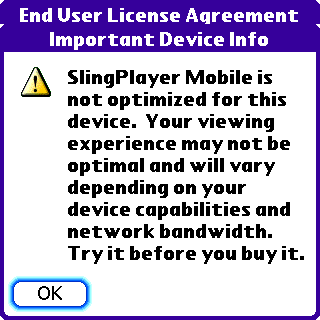
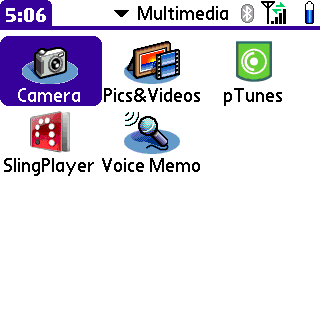
Once you install SlingPlayer for Palm OS, this is what you will see in the Application launcher on Palm OS. Well, the icon anyway, you may not have the same applications that I have installed, of course.
The fist time you run SlingPlayer you’ll start with the Quick Start Tips. I do recommend reading through them to get started. In my experience, the most useful tip is using the space bar to toggle into ’123′ mode to be able to use the 5-way for on-screen navigation. These screens are accessible through the menu for future use.
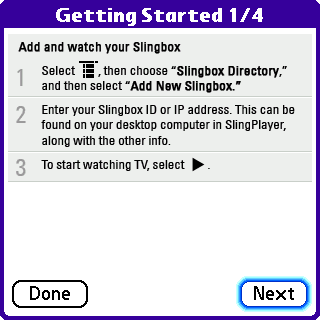
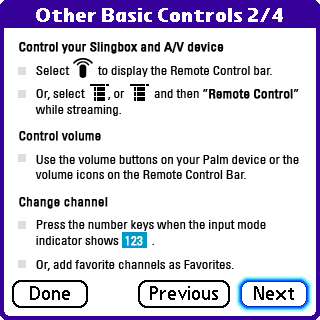
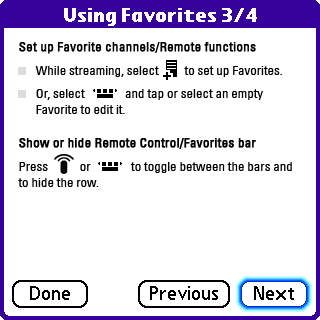
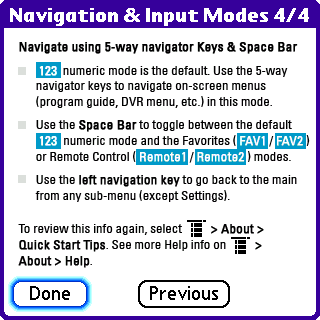

When you first launch the application it will ask you to register. You have 30 days to use the application without registering, and it will count down each day.
This is the first screen you see when you start the player. Selecting the ‘Play’ icon will connect to the Slingbox. The icon on the right enters the menus.
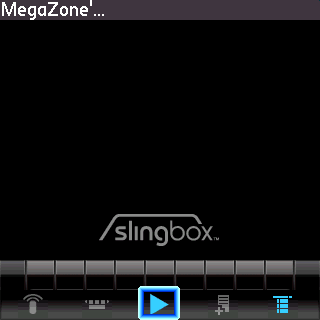
Let’s walk through the menus. The main menu screen will have some options grayed out if the player has not been connected to a Slingbox yet, as seen here.
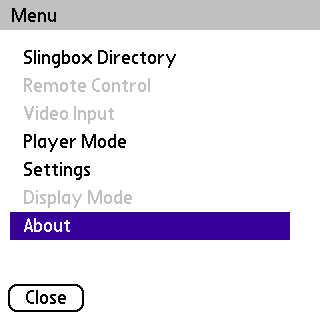
The become available once you’ve connected.
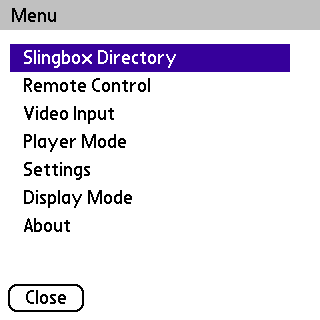
You select the Slingbox to connect to and add Slingbox connections in the Slingbox Directory.
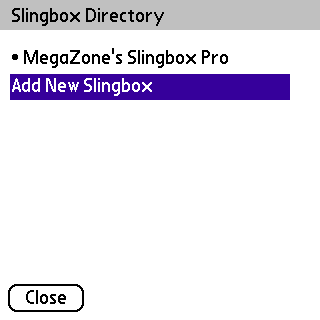
When you select an existing Slingbox you can Watch, which connects to the Slingbox, edit the Properties, or Remove it.
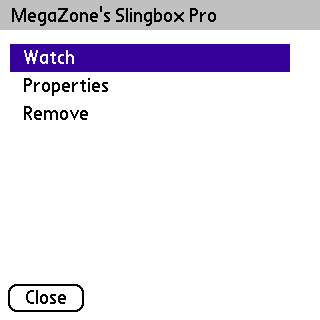
When you add a new Slingbox you can access it via the Slingbox Finder ID or the IP Address.
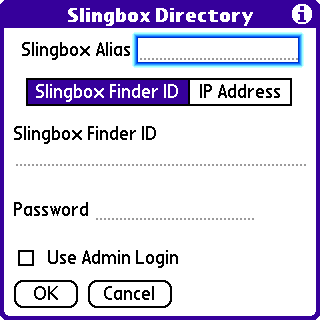
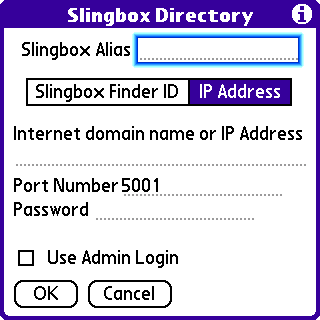
The Slingbox Directory is one of only two screens with the info icon in the upper-right, which opens Tips. The tips will walk you through the steps to setup a new Slingbox, but, honestly, it is fairly obvious.
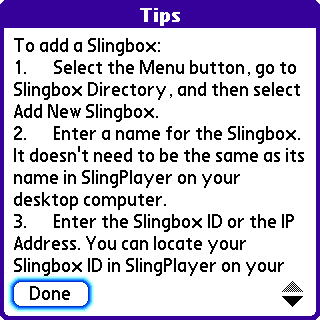
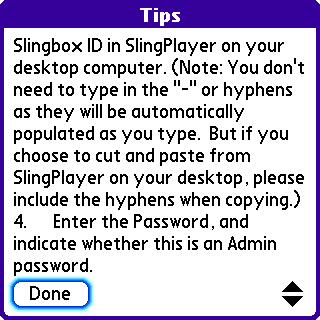
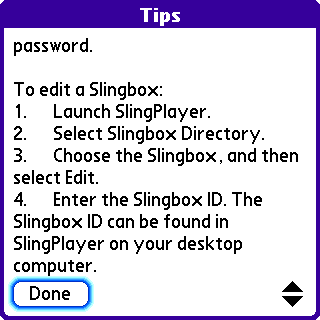
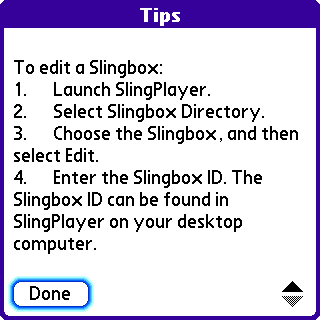
The Remote Control screens will vary depending on the device connected to that input on the Slingbox. These are the screens for the Series3 TiVo, which I have on the HD Connect input.
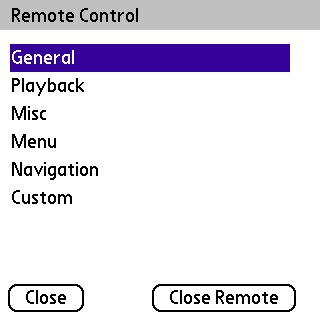
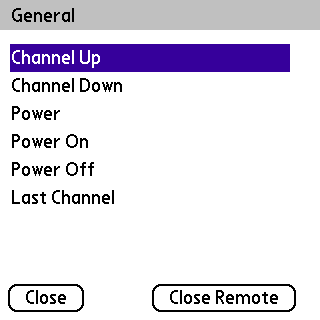
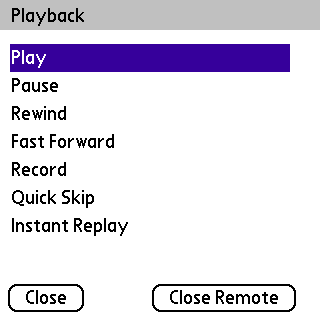
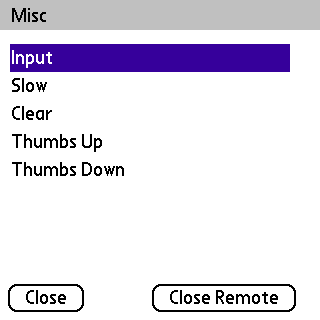
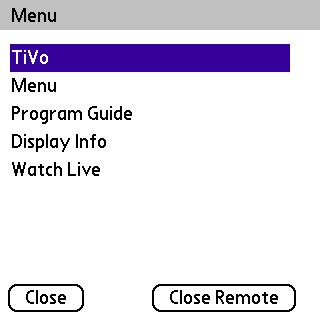
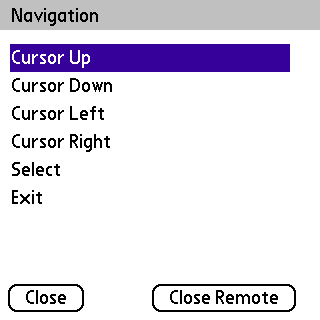
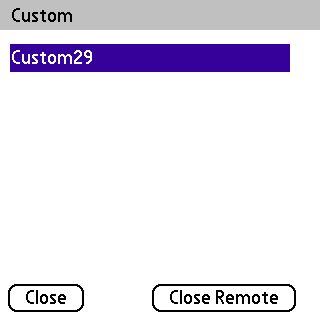
The Video Input screen shows you the different inputs on your Slingbox, and allows you to select the one you want to watch. I have a Slingbox Pro fed directly via cable, a TiVo Series2 on the S-Video input, and a TiVo Series3 on the HD Connect input.
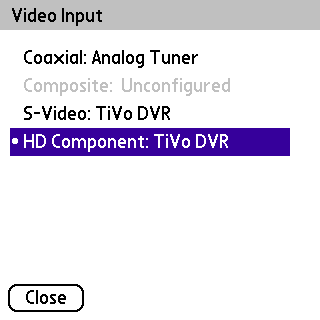
The Player Mode is simply a choice between Audio Only and Normal (meaning video) modes.
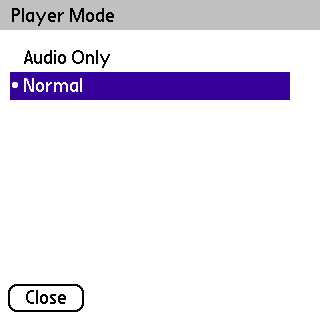
The Settings screen would perhaps be better named Audio Settings, since that is the main function. You can select between mono low and high, and stereo low and high. The default is mono low. Since the Treo has a single speaker, there is no real benefit to using stereo. Mono uses less bandwidth on the audio, allowing more to be used for the video. If you use a stereo headset, then using stereo probably makes sense for you.
The other option on this screen is ‘Show Statistics’. If you check this box then SlingPlayer will display the data rate (in Kbps) and frame rate (in fps) on the upper-right of the playback screen.
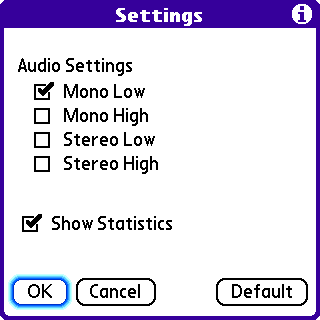
The Settings screen is the other screen with the info icon and a Tips screen. The Tips screen simply explains the settings, which are already fairly intuitive.
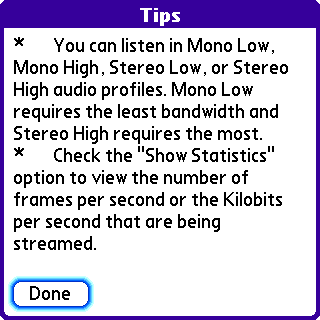
The Display Mode is a simple choice between Normal (4:3) and Letterboxed (16:9) modes. Select the one appropriate for your source. On minor complaint is that this is global for the player, and not specific to an input. So, for example, when I switch between my S3 (16:9) and S2 (4:3) I have to remember to change this to avoid distorted video. But that’s a minor quibble, really.
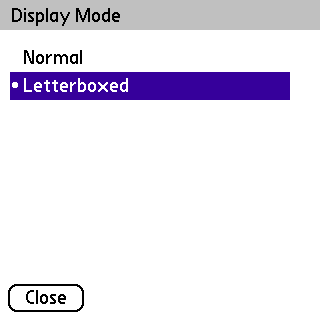
The last item is the About screen. The first selection there are the Quick Start Tips, which we saw earlier. This is where you access those if you need to reference them after the first time you run SlingPlayer.
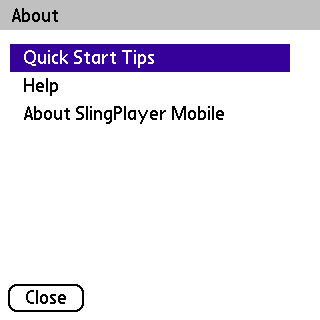
The Help screens are really worth reading through before you jump into the application. They contain useful information, such as the keyboard shortcuts. Really, the Help screens are more like the product manual. It is the only explanation you have for the different functions and features.
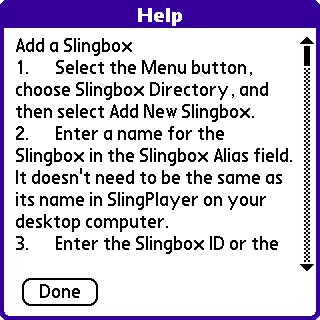
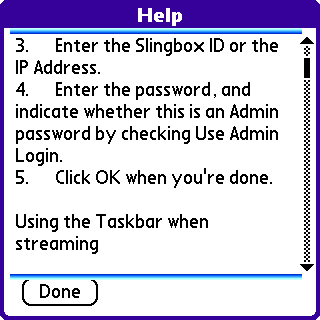
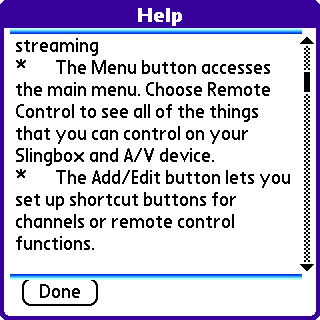
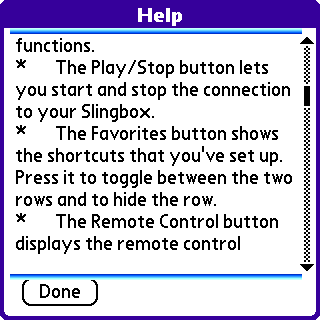
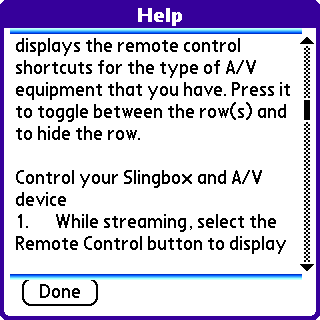
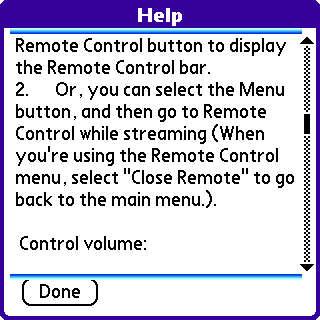
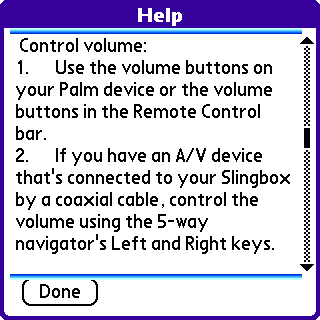
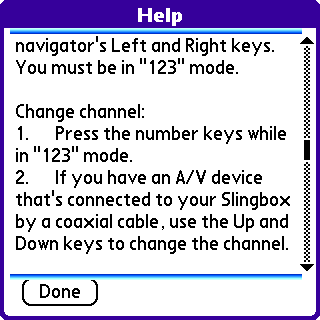
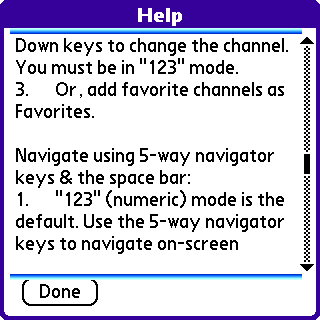
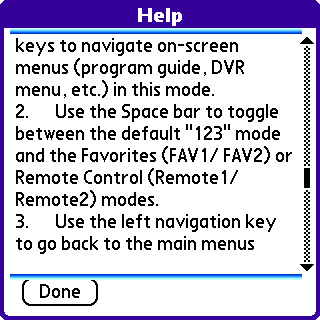
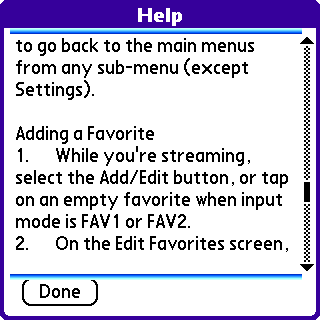
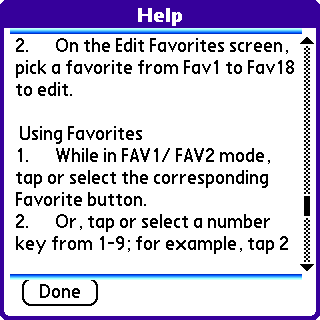
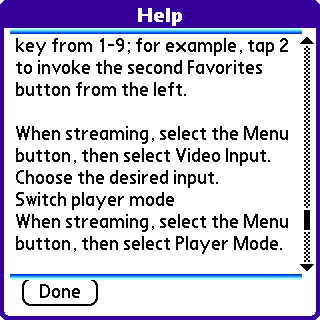
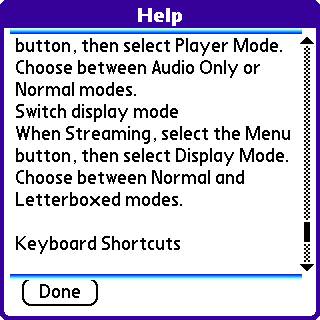
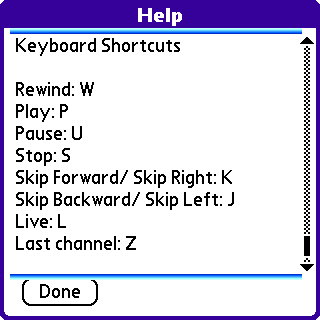
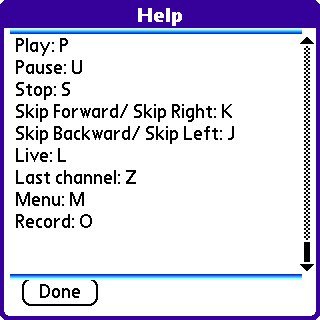
And, finally, we have the About SlingPlayer Mobile screen, which provides the version number, copyright, etc.
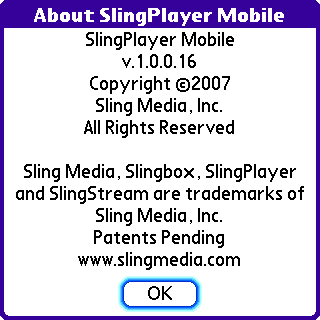
Well, wasn’t that fun? Yeah, OK, so menu screens are kind of boring. But I’m sure one or two completeists out there are happy. You can’t complain that I skipped something. So now, let’s connect to my Slingbox so I can show you the SlingPlayer UI.
Unfortunately, it looks like the Palm OS screen capture utilities I tried can’t capture the video itself. Whenever I tried, it would only capture the UI with a black area where the video should be. It probably relates to the way the video is written to the screen, since the capture utilities grab the screen buffer. Sorry.
When you first connect, the screen will say Locating… as it looks for your Slingbox.
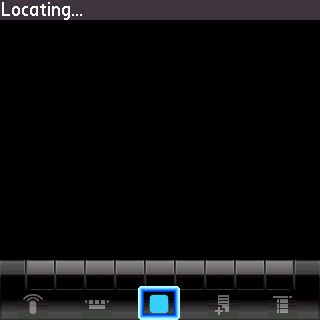
Once it has connected, that changes to Starting…
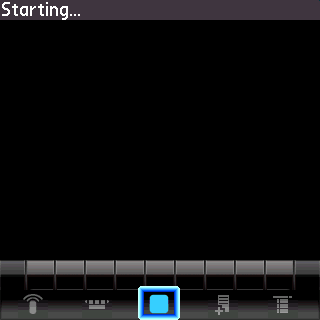
If the device feeding the Slingbox is not on, this is the screen you will see. I tend to keep my TiVos in Stand By, so I see this each time I connect until I wake them up.
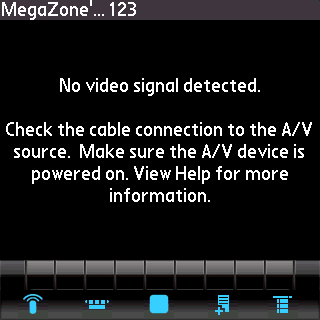
This capture was taken during video playback. You can see what I mean about the black pane instead of video. The reason I’ve included this is to show the statistics display in the upper right. The player appears to be software limited to 15fps. While I have seen it spike as high as 19fps, that has only been during very static content. During normal playback, even as the bit rate fluctuates, the frame rate remains at 15fps.
Note that this is very watchable, so this isn’t a complaint. I just want to point that out so people don’t wonder why they can’t get higher frame rates.
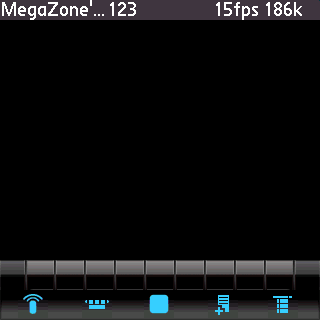
The left-most icon switches the SlingPlayer UI into remote control mode. The bar under the video pane shows the remote control functions. There are two sets of controls and selecting the icon repeatedly toggles between them. Or you can use the arrows at either end of the bar.
The bar’s controls are pre-set and cannot be customized.
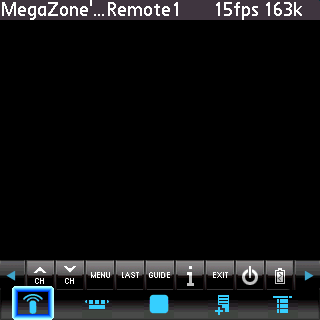
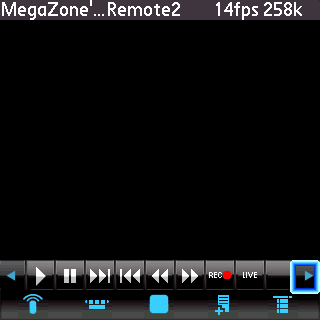
Note the battery icon on the first remote screen, on the right end of the bar. If you select that, it brings up the battery indicator in the upper right. This was a late addition to the software, just before final release.
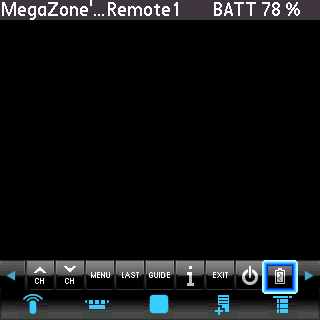
The second icon switches into Favorites mode. As with the remote control bar there are two sets of buttons. By default they’re all blank, you can customize them as you see fit. To demonstate, I’ve selected a number of TiVo controls.
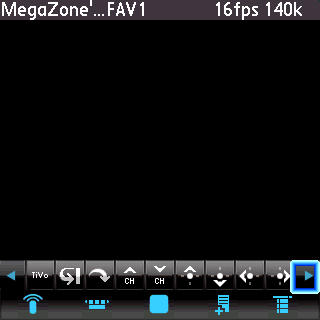
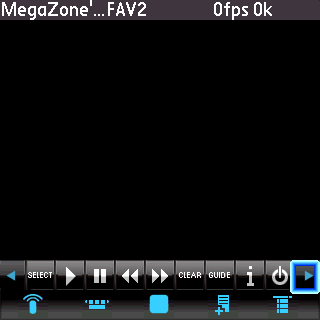
To edit the Favorites you can select a blank button, or select the fourth icon along the bottom. If you select the icon, the first screen allows you to select the button you wish to edit.
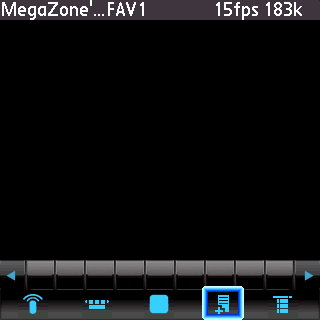
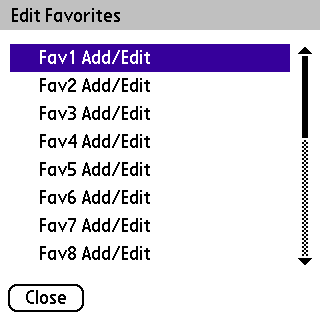
Favorites buttons can be customized with the included Channels with Logos, Custom Channels, or Remote Control Functions.
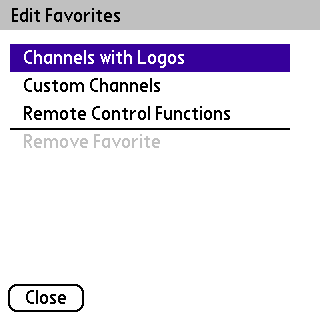
OK, so I didn’t screen capture the entire list of logo channels. It goes on like this for about 30 screens. You’ll just have to install the application to see the list for yourself.
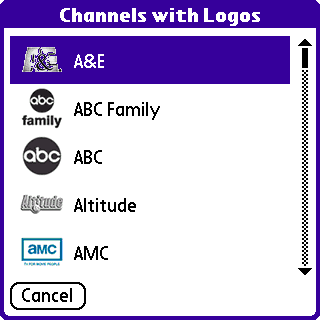
When you select a channel, you are then prompted to enter the number for that channel.
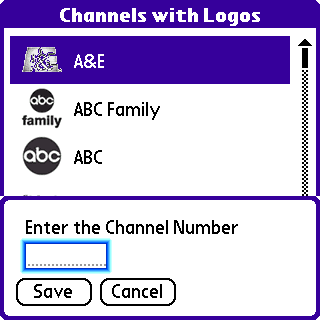
For the Custom Channels you enter a name and number.
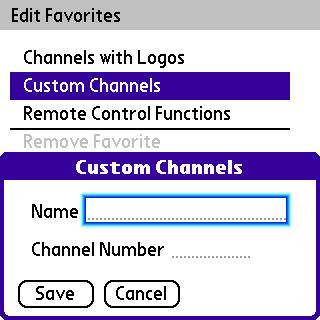
For Remote Control Functions, the available options will depend on the device(s) you have attached. Since I have TiVos atached, I have TiVo remote otions.
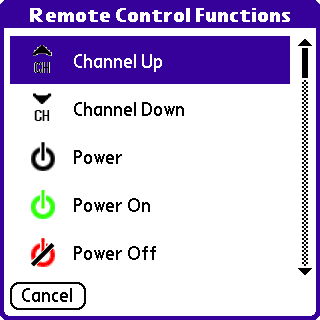
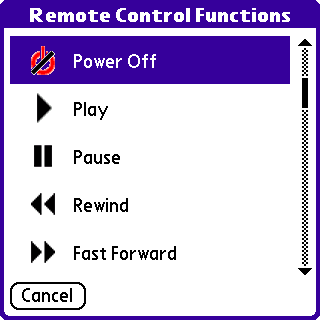
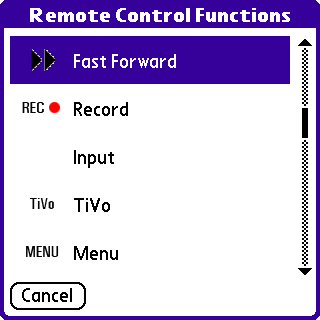
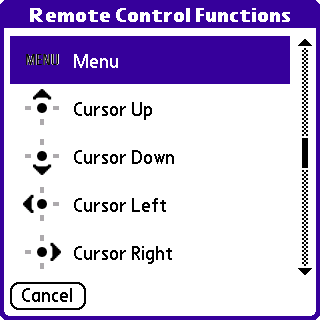
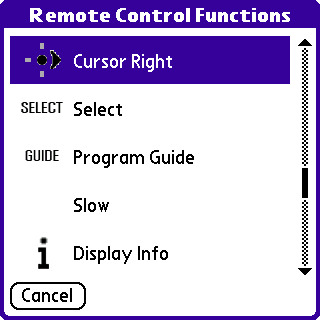
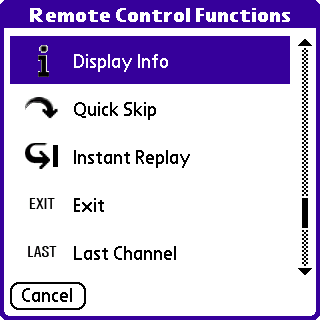
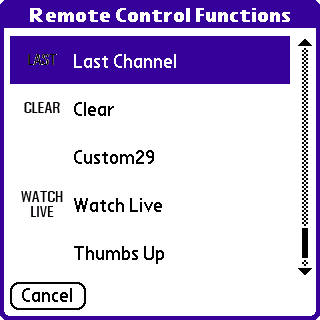
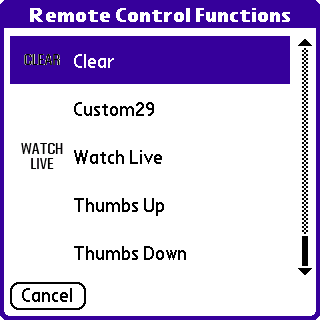
And that’s all folks! Now you’ve seen everything (OK, except all the channel logos) and you should be downloading this to your Treo right now.
Final Words
After five months using SlingPlayer Mobile on my Treo, my overall impressions are positive. There are a few minor issues, but the important thing is it works, and works fairly well. As long as you have a solid data connection video playback is good. There is occasional pixilation as data rates fluctuate, but I’ve been able to watch video for over an hour at a time without any major disruptions.
So, if you have a compatible Palm and a Slingbox, and an unlimited data plan, I’d download the software and give it a try. You have 30 days to decide to purchase, or not, so you have nothing to lose. Give it a try!
Tools Used
The main tool I used in producing this review was Snap for Palm OS screen capture.
To convert the BMP captures into PNG, which reduced the file size from 300KB+ to 4-16KB, I simply opened the BMP files in Windows Picture and Fax Viewer and saved them out as PNG files, renaming them in the process.
I created the XHTML by hand in emacs. I’m old school. ![]()
The EULA screens I promised above:
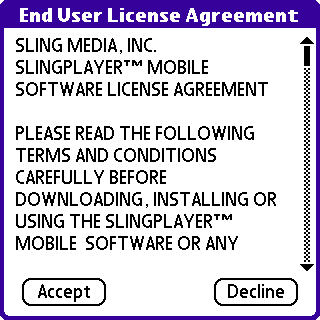
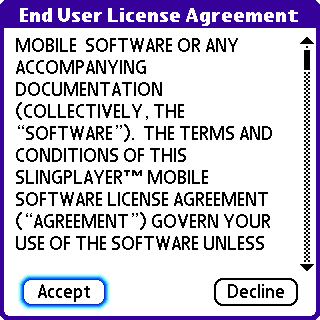
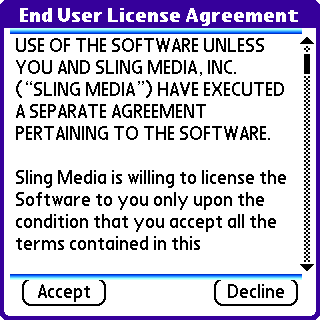
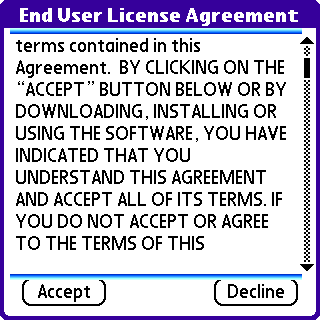
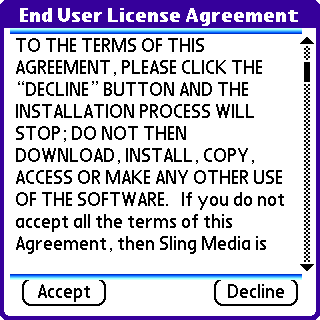
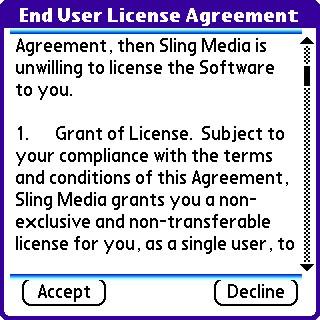
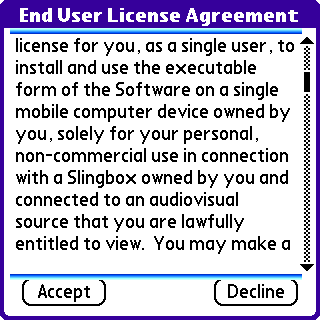
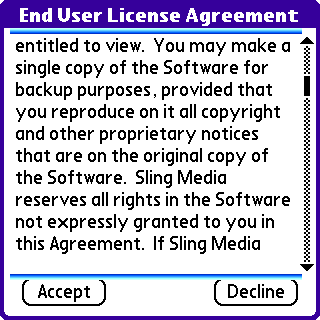
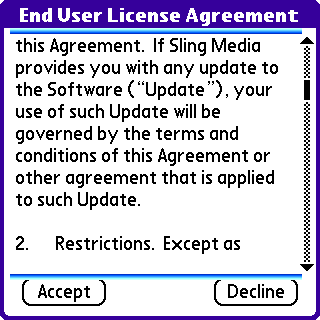
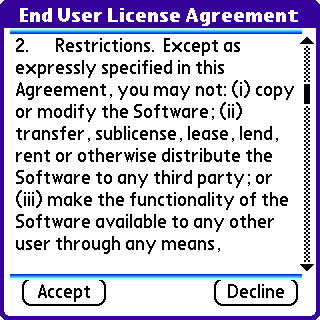
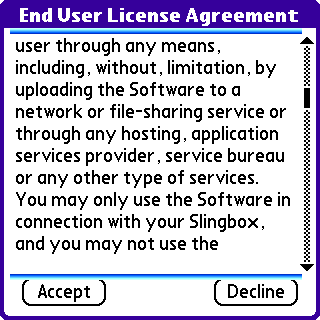
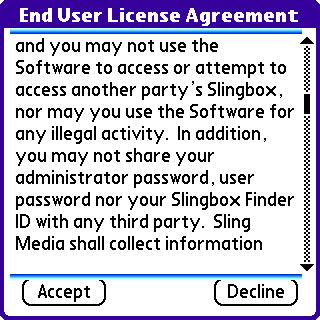
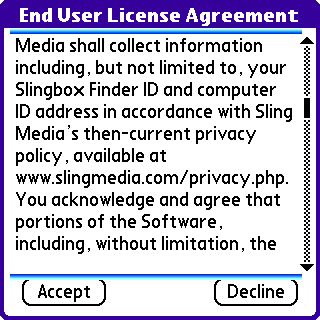
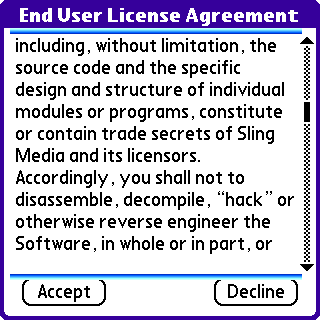
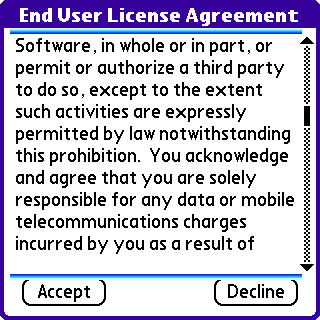
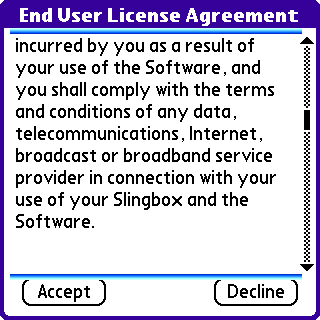
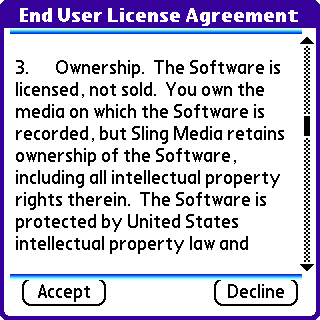
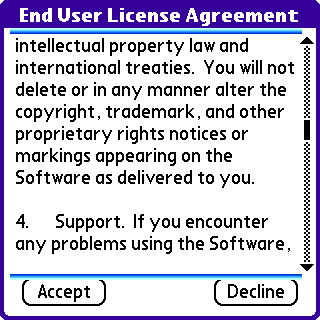
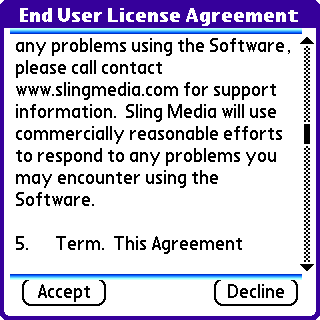
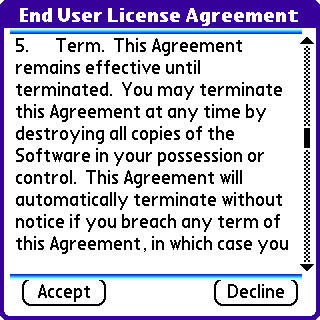
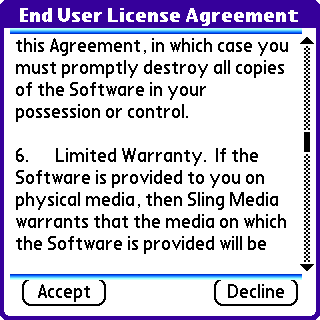
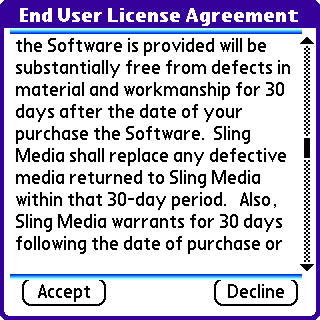
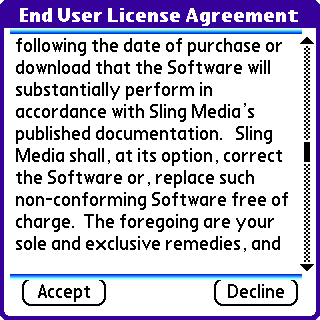
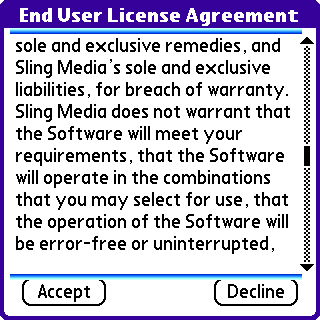
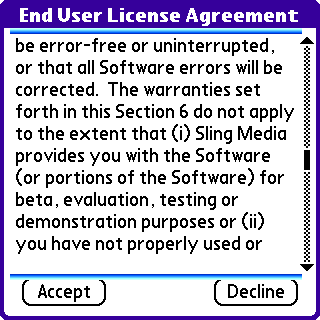
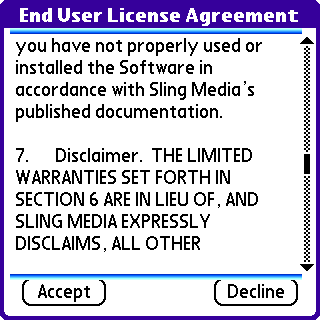
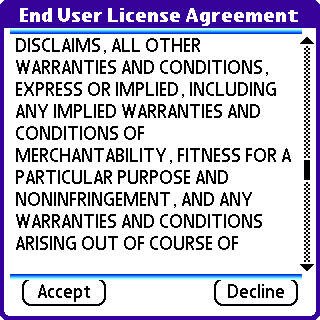
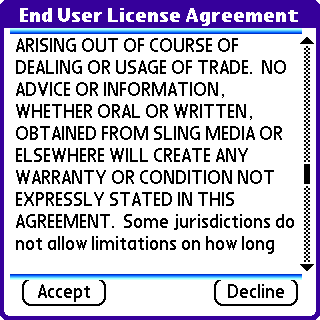
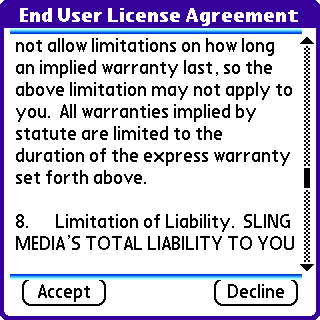
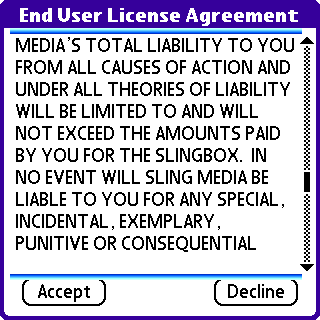
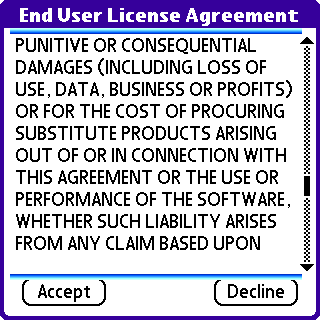
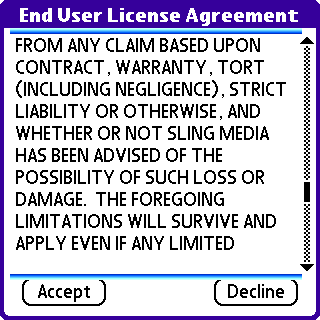
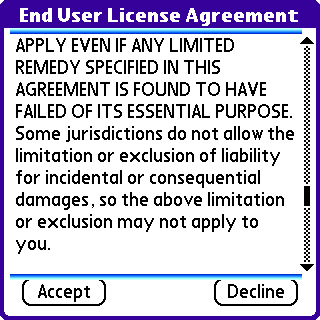
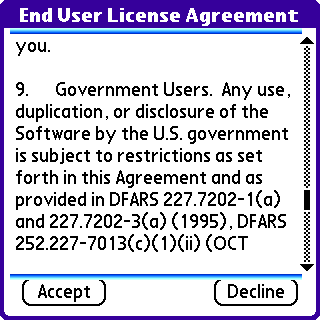
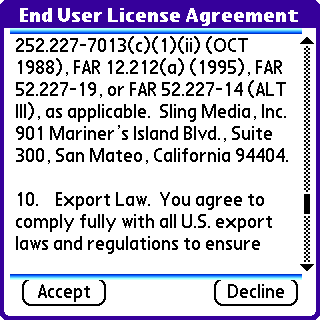
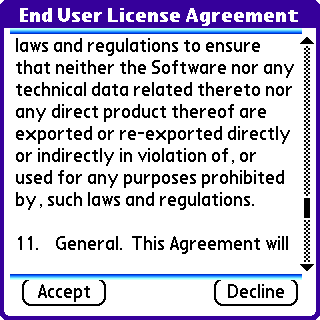
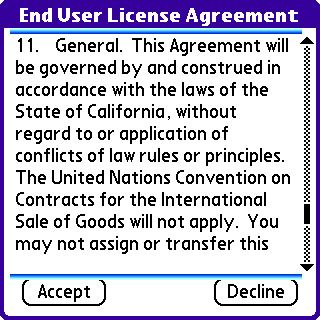
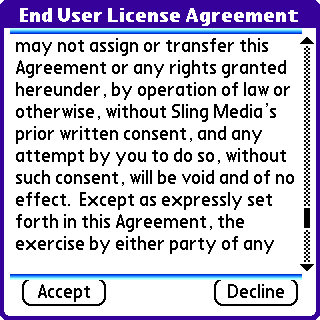
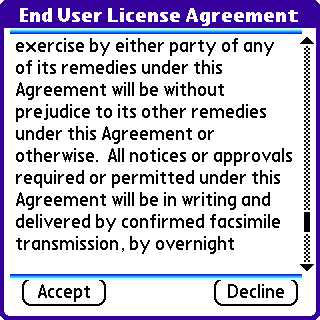
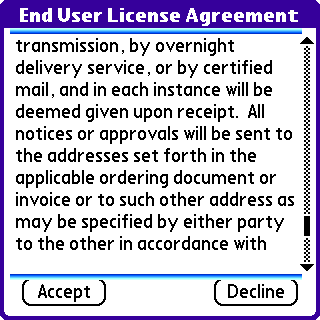
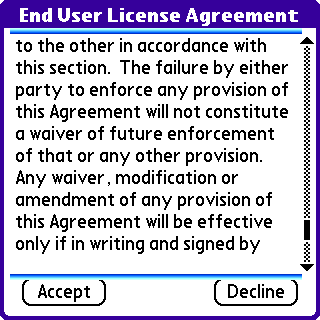
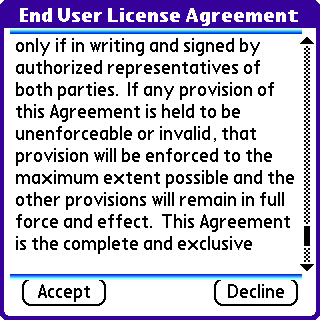
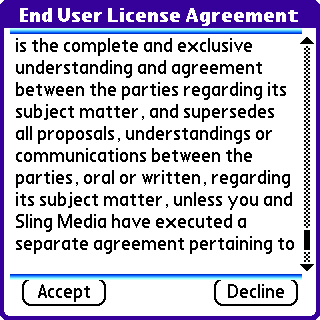
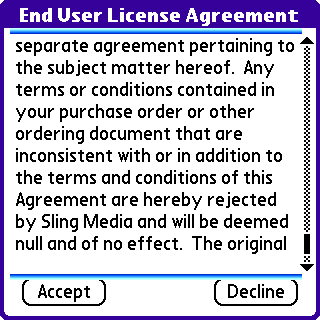
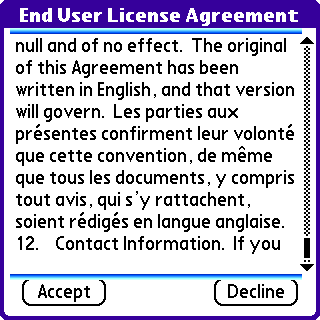
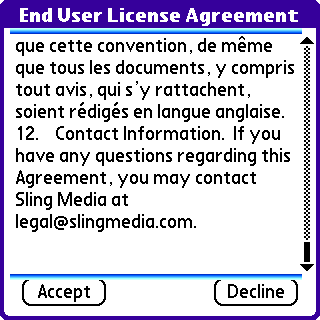





Pingback: SlingPlayer Mobile for Palm OS goes gold! Release 1.0 is out! | Gizmo Lovers Blog